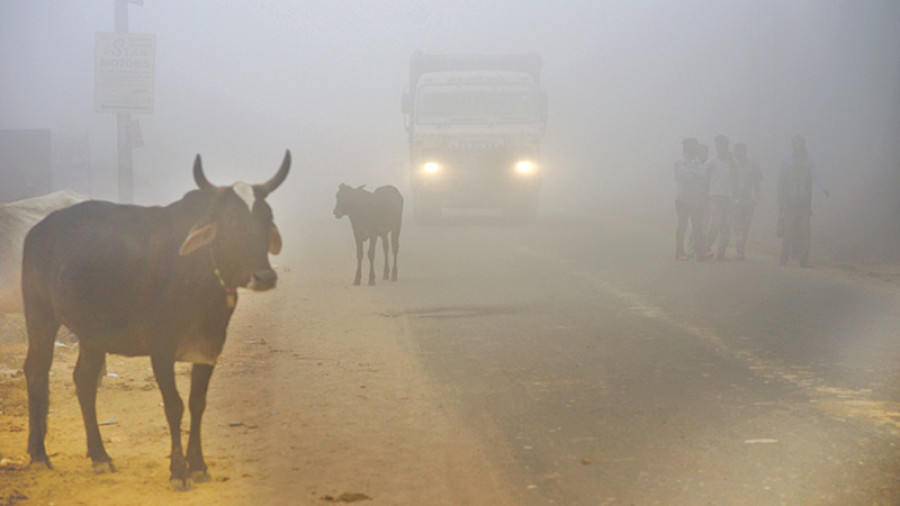Opinion
Sounding the alarm
Delhi’s smog is a warning for all countries and cities in Asia where the pollution level is high
Shyam Kc
As I sat down to resume my long delayed, dormant column, almost all Indian television news channels available in Nepal seem to be warning the people of the Indian capital to stay indoors and not to venture out into the open unless absolutely necessary. Schools were closed and there were a number of vehicle accidents due to visibility problems. To anyone who keeps an eye on the pollution graph, the present unbearable situation in Delhi was something that was bound to happen. In the past, the Delhi government had even contemplated the idea of enforcing a rule that would require even and odd number vehicles to ply the Delhi streets only on alternate days. The Delhi government is said to be contemplating bringing this rule into force this time because the high level of air pollution in the city poses a health threat to all people, irrespective of whether they are rich or poor. There is little chance that one can escape the effects of air, water and sound pollution no matter where one lives, whether in the Himalayas or in highly developed countries like the United States.
Long lasting impacts
High levels of pollution are not only a threat to the present generation, but the ones to follow as well. Pollution affects the climate and brings about deadly climate change. Such climatic changes, according to experts, are already taking place at a pace much faster than was previously anticipated. Climate change and the resultant global warming can have a very damaging effect on the whole human race. No wonder the great physicist Stephen Hawking has given human kind just 1,000 years to find another habitat in outer space to ensure that the human race continues to survive, because by then, according to Hawking, the earth will become unliveable due to climate change and human folly regarding nuclear technology. Though the pollution index shows that most of the pollution takes place in the Asian region, the United States and the European Union are among the highest carbon emitters. The developed countries are the ones that top the list of highest carbon emitters.
Under the circumstances, one can only marvel at the decision of the US President Donald Trump to pull out of the Paris Accord irrespective of the better sense shown by other leaders, including those from Europe. The French President is said to have indicated that he would not be inviting President Trump to the follow-up of the Paris Accord that is to take place next year. The Paris Agreement is an attempt to slow down climate change and, if possible, to reverse the change. The controlling of carbon emissions will go a long way in the attempt to slow down climate change. But then development as we understand it today means generating employment through the development of more and more industries, which translates to the burning of a lot more coal that will pollute the atmosphere further. World leaders need to think not merely about the present, but of the long term future when such vital issues are concerned and when the very survival of human race depends on their actions.
Taking note
The pollution levels in Delhi were only to be expected. The smog that engulfed the Indian capital should serve as an alarm to many countries and cities in South Asia. The fact that many of the cities of South Asia, including Kathmandu, are at the top of the pollution index indicates just how much more needs to be done to control pollution in South Asia (Kathmandu with an index of above 90 is among the top five cities in the world with a high rate of pollution).
The Kathmandu where I grew up as a child no longer exists. Where has all the greenery gone? Tall and senseless buildings have replaced green paddy fields. The ownership of motor vehicles including motors bikes have grown by leaps and bounds even though Kathmandu, Lalitpur and Bhaktapur were not built to manage such motorised traffic. The Kathmandu Valley used to be covered by fog just before the onset of winter but now the everything is clear and, when there is mist around, one does not know if it is fog or the deadly smog. The proliferation of motorised vehicles and their carbon emission have contributed a lot towards making Kathmandu one of the most polluted cities in the world. Our leaders either are not aware of the gravity of the problem, or are ignoring the problem even if they are fully aware of the after-effects of air pollution and the threat such pollution poses to the health of the people. This has been true irrespective of the type of government we have—whether it be a democracy, a traditional Panchayat system, or a total dictatorship. The senseless felling of trees and random permits to construct buildings on what were once paddy fields in the Valley has a lot to do with the rise of the pollution index in the Valley in general and in Kathmandu in particular. The alarm that the situation in Delhi sounded is a warning signal not only to the Indian capital but also to all countries and cities in Asia where the pollution level is high. It is particularly relevant to the Kathmandu Valley, which should realise that if such a pollution situation can take place in Delhi, which is relatively open in all directions, what would be the situation in a place like Kathmandu that is surrounded on all sides by hills and mountains?




 19.12°C Kathmandu
19.12°C Kathmandu










